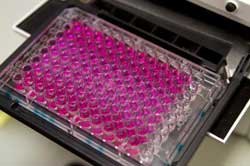NIH tools facilitate matching cancer drugs with gene targets

This is a cell plate with cell lines from the NCI-60. Credit: NIH/National Cancer Institute<br>
The newly updated software, called CellMiner, was built for use with the NCI-60, one of the most widely utilized collections of cancer cell samples employed in the testing of potential anti-cancer drugs.
The tools, available free, provide rapid access to data from 22,379 genes catalogued in the NCI-60 and from 20,503 previously analyzed chemical compounds, including 102 U.S. Food and Drug Administration-approved drugs.
The study, written by the scientists that developed the tools at the National Cancer Institute (NCI), part of the National Institutes of Health, appeared in the July 16, 2012, issue of Cancer Research.
“Previously you would have to hire a bioinformatics team to sort through all of the data, but these tools put the entire database at the fingertips of any researcher,” explained Yves Pommier, M.D., Ph.D., of the NCI's Center for Cancer Research. “These tools allow researchers to analyze drug responses as well as make comparisons from drug to drug and gene to gene.”
Genomic sequencing and analysis have become increasingly important in biomedicine, but they are yielding data sets so vast that researchers may find it difficult to access and compare them. As new technologies emerge and more data are generated, tools to facilitate the comparative study of genes and potentially promising drugs will be of even greater importance.
With the new tools, available at http://discover.nci.nih.gov/cellminer, researchers can compare patterns of drug activity and gene expression, not only to each other but also to other patterns of interest. CellMiner allows the input of large quantities of genomic and drug data, calculates correlations between genes and drug activity profiles, and identifies correlations that are statistically significant. Its data integration capacities are easier, faster, and more flexible than other available methods, and these tools can be adapted for use with other collections of data.
Researchers looking at a particular drug can use the tools to access data from previous experiments done on that drug and analyze how the drug relates to other drugs and various gene profiles. As a case example for this study, the researchers compared drug activity levels and gene expression patterns from previous research to identify an investigational compound, called NSC732298, which is not currently being studied for colon cancer, but could be a potential therapy for the disease based on a CellMiner gene-drug match. In the same exercise, the researchers were able to identify that a second investigational drug that is being tested for colon cancer, called selumetinib, might also be effective against melanoma.
“We're looking forward to seeing how other people are going to use this tool to look at gene co-regulation, regulation of gene expression, and the relationship between gene expression and cancer,” said Pommier.
This work was supported by NCI's Center for Cancer Research and Division of Cancer Treatment and Diagnosis under intramural project number ZIA BC 006150.
NCI leads the National Cancer Program and the NIH effort to dramatically reduce the burden of cancer and improve the lives of cancer patients and their families, through research into prevention and cancer biology, the development of new interventions, and the training and mentoring of new researchers. For more information about cancer, please visit the NCI Web site at www.cancer.gov or call NCI's Cancer Information Service at 1-800-4-CANCER (1-800-422-6237).
About the National Institutes of Health (NIH): NIH, the nation's medical research agency, includes 27 Institutes and Centers and is a component of the U.S. Department of Health and Human Services. NIH is the primary federal agency conducting and supporting basic, clinical, and translational medical research, and is investigating the causes, treatments, and cures for both common and rare diseases. For more information about NIH and its programs, visit www.nih.gov.
Reference: Reinhold WC, Sunshine M, Liu H, Varma S, Kohn KW, Morris J, Doroshow J, and Pommier Y. Web-based genomic and pharmacologic tools for gene and microRNA transcript levels, drug activities, and their pattern comparisons across the NCI-60. Cancer Research. July 16, 2012.
Media Contact
More Information:
http://www.nih.govAll latest news from the category: Health and Medicine
This subject area encompasses research and studies in the field of human medicine.
Among the wide-ranging list of topics covered here are anesthesiology, anatomy, surgery, human genetics, hygiene and environmental medicine, internal medicine, neurology, pharmacology, physiology, urology and dental medicine.
Newest articles

Properties of new materials for microchips
… can now be measured well. Reseachers of Delft University of Technology demonstrated measuring performance properties of ultrathin silicon membranes. Making ever smaller and more powerful chips requires new ultrathin…

Floating solar’s potential
… to support sustainable development by addressing climate, water, and energy goals holistically. A new study published this week in Nature Energy raises the potential for floating solar photovoltaics (FPV)…

Skyrmions move at record speeds
… a step towards the computing of the future. An international research team led by scientists from the CNRS1 has discovered that the magnetic nanobubbles2 known as skyrmions can be…





















